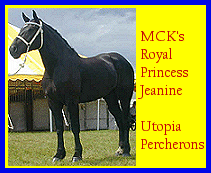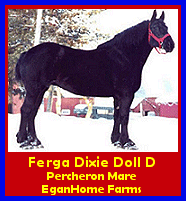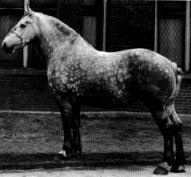| Origin: The Perche district of France. Color: Gray or black. Avg Height: 14.3 to 17.3 hh Avg Weight: 1320 to 2200 lbs |  |
Build: The Percheron has a deep, compact body with sloping shoulders, a wide chest and strong back, and well-proportioned quarters. Its limbs are clean, short, and strong, with heavy, flat bone; its feet are hard and open, with bluish hoofs. The Percheron has a large proportion of Arab blood in its makeup, and this is particularly evident in its characteristically small, fine head, silky coat, and fine skin.
| Temperament: Even temperament and excellent manners. Main use: Meat, tractive power. |  |
Special abilities: There was also a smaller, lighter type, known as the Percheron Postier, but its numbers are either extinct or very close to it.
History: Strong, hardy, energetic, and easy to break and handle, the Percheron is one of the most popular and widely distributed of the heavy draft breeds. Its home is the Perche district of France, an area of rich pasture lying to the west and southwest of the Parisian basin, but the breed is also established in Britain, the US, and Argentina, as well as in many parts of western Europe. Except for the recent past, the history of the Percheron breed is not exactly clear. The ancestors of the modern day Percheron served as war horses carrying knights into battle instead as draft animals in the field. Those horses were light, sure-footed and spirited. As agricultural pursuits began to take precedence over battles, these horses were bred more for size, weight and strength. The French, however, kept very few records regarding breeding which allows for speculation on the breeds true origins. It is widely believed that the Arabian horse played an important role in the development of the Percheron. By the time of the crusades, the Percheron breed was widely recognized as outstanding for his substance and soundness, as well as for his characteristic beauty and style. By the 17th century horses produced in Le Perche had attained widespread notoriety and were in demand for many different uses. The Percheron of this time showed less scale and easily adapted to pulling the heavy mail coaches of France. They stood from 15 to 16 hands high at this time. In the early 19th century the French government established a stud at Le Pin for the development of army mounts. In 1823, a horse named Jean La Blanc was foaled in Le Perche and all of today's Percheron bloodlines trace directly to this horse. Edward Harris of Moorestown, New Jersey first imported Percherons to the United States in 1839. Although in his two attempts to import eight Percheron horses to America, only two survived the journey, a mare named Joan and a stallion called Dilligence. These two horses helped establish the Percheron breed in America. Diligence reportedly sired over 400 foals with three of his being recorded among the foundation stock in the first American Percheron stud book in 1876. No other Percheron importations were recorded until 1851. The stallions, Normandy, Gray Bill and Louis Napoleon, were imported in that year. Louis Napoleon had a profound effect on the Percheron breed in America and is owners were instrumental in the forming of the Percheron Association in 1876. Thousands of Percherons were imported to Americans in the last half of the 19th century, and importations continued up until World War II. The Percheron quickly became the favorite of both the American farmer and the teamster who would move freight on the nation's city streets. The Percheron was so popular that by 1930, the government census showed that they were three times as many registered Percherons as the other four draft breeds combined. Following World War II, the invention of the modern farm tractor made the breed nearly extinct. As America modernized and mechanized, the Percheron was all but forgotten. However, a handful of farmers including many Amish, dedicated to the preservation of the breed, kept it alive through the next twenty years of the draft horse depression which lasted through the 1950s and 1960s. The late 1960s saw a renaissance in the draft horse business as Americans rediscovered the usefulness of the draft horse. Today, Percherons are back on small farms and working in the fields and thousands of are used for recreation such as hayrides, sleigh rides and parades.

For Breeders, Farms, and Studs of this breed, click here.
If you have a horse of this breed, and you would like to see your pictures posted here, or if you would like to advertise your business that involves this particular breed, you can also email me.
I'm not perfect, and I never claim to be! If you see anything here that you believe I am wrong about, please feel free to email me. I might not agree with you, but at least I will listen!! :0) Can you fill in any of my blanks? Do you know of information or links that you would like to share with draft animal enthusiasts that you don't see here? Am I missing anything? Let me know at Draftladyb@yahoo.com.